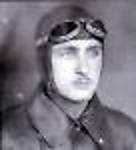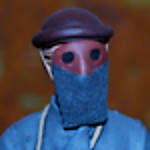The recent review of the Eduard’s Weekend Edition Fokker D.VII was my personal “wild-card” into the world of Early Aviation. Although I reviewed the X-resin’s PWS-A at some point earlier, my interest and knowledge of the Early Aviation Era is trifling. However, learning from the early aviation aficionados here on Aeroscale, I was tempted to expand my knowledge on the subject and sign up for this campaign.
My area of interest is WWII subjects, especially the Luftwaffe fighters. But from a historical point of view, I am very much interested in all aviation subjects that are somehow related to my country, and especially to my hometown – Sarajevo. Roaming through the Early Aviation Forum on Aeroscale, I’ve noticed some very interesting names that rang my bell, but none like the name of Oblt. Miroslav (Fridrih) Navratil. Here is a short biographical info about this Austro-Hungarian flying ace. It is my small tribute to my compatriot who fought “the other peoples wars”, as the Great War is often referred to in our historiography.

The pilot. Miroslav Navratil was born in Sarajevo on June 19, 1893. The Historical Museum of Bosnia and Herzegovina in Sarajevo holds no record of his earlier career, although his latter collaborationist biography during the WWII is very exhaustive.
Upon successful completion of primary and secondary school in his hometown, Navratil attended Infantry Cadet School in Graz (Libenau). He served with the First Bosnian-Herzegovinian Infantry Regiment on the Serbian front, where he was wounded twice in 1914. His regiment saw action in the battlefields of Italy, Montenegro and Romania. While serving with the regiment, Navratil was promoted to Oberleutnant, and soon after that he was wounded again in December 1916.
Tired and at dismal with the infantry, he joined the K. und K. Luftfahrttruppe (LFT) the following month, and received training as observer at Wiener-Neustadt. In July 1917 he was initially posted to Flik 13 at Galicia, only to be transferred to Flik 11 in October of the same year. After pilot training in November 1917, Navratil scored one victory with Flik 41J before assuming command of Flik 3J on June 9, 1918. With the former unit he scored nine more victories by the end of the Great War, with two additional and unconfirmed victories.
After the WWI ended, Navratil briefly served with the Yugoslav Royal Airforce. He was soon promoted to the rank of lieutenant colonel for his exceptional achievements. However, Navratil had to face the accusations of high-ranking Serbian officers for being pro-German in the wake of the WWII, because he insisted on the acquisition of German aircraft for the weakening Yugoslav air-force. The April war finds him in Zagreb, where he worked as a part-time journalist and military analyst.
With the establishment of the Independent State of Croatia (NDH) in April 1941, he is set in charge of the nascent air force, but is soon appointed as a military attaché in Bucharest. He was promoted to the rank of colonel general in August 1943, and acted as Croatian Minister of War from September 2, 1943 to January 29, 1944. After his dissent and quarrels with Ante Pavelić, who was the head of the NDH, he was again sent to Romania as ambassador, and soon retired.
Navratil moves with his family to Vienna in November 1944, where he waits the end of WWII. He was soon captured by the Americans and imprisoned at military camps in Giolling and Gmunden, only to be handed over to the new Yugoslav communist regime in December 1946. He was accused of war crimes and executed on June 7, 1947.
With Navratil’s biography in mind, and with my policy not to comment extensively on historically established facts, I wanted to pay homage to this particular KoTS by building my first WWI subject – Albatros D.III (OEFFAG 235). Some of you may be aware of the fact that one of the marking options in the Eduard’s Profipack edition (kit #8248) enables you to depict the 235.116, which was one of the aircrafts flown by Navratil in the Fall of 1918.
The aircraft. I did some historical research on the Navratil’s aircraft. However, none of this would be possible without the previous efforts and research by Dalibor Feuereisl, whom I wanted to credit by rough translations of the material available on his website, which is dedicated to the history of this particular aircraft. The site is, unfortunately, in Czech, but I managed to roughly translate the points of interest for my fellow modelers. I am to be credited for any mistakes in translation.
Albatros D. III (OEF) 253.116, with engine nr. 23266, was manufactured in September 1918 and delivered to Flik 3J, where it became the second personal machine of Oblt. Navratil. The aircraft was decorated with the same personal signature as the previous 253.06, i.e. heart stabbed with an arrow. Oblt. Miroslav Navratil is credited with ten aerial victories, eight of which he made with the previous aircraft. Identical “personal” signature, however, makes it very difficult to distinguish between the two aircraft on the existing photographs from the period. Virtually identical serial numbers on the machines, which are partially covered by the signature, can be distinguished only by comparing the somewhat differing trailing edges of the both arrow endings, or by identifying the Mausers mounted on the upper wing of 253.06.

Of particular interest is probably one of the last photos of 253.06 at the Flik 3J Airport in Gardolo from August 1918 (above). The aircraft on the photo, from left to right, are: 153.173, 153.225, 253.06, 153.227, and possibly 153.244. The Navratil’s aircraft – the third from the left – has his distinctive “personal” signature; however, of particular interest is a non-standard cross applied on the rudder. It is the exact machine in which Oblt. Navratil crashed during a training flight on the October 21, 1918 after an unsuccessful emergency landing due to the seat malfunction. The aircraft was completely destroyed, and Navratil was hospitalized with serious injuries. He didn’t return to the battlefield until the end of the war.
When the end of war was declared, Zgsf. Adolph Bláha, one of the Czechs serving with the Flik 3J, was at the airport in Innsbruck, where the unit was transferred early in November 1918. On November 21, 1918, Bláha decided to desert from the unit in Oblt. Navratil’s Albatros D.III (OEF) 253.116. Stfw. Béla Mayer, who deserted with Bláha, flew over in Albatros D. III (OEF) 253.114. Due to navigational error and bad weather, both flyers landed at Schlieren, near Zürich. The aircrafts and the pilots were photographed, and the machines were transferred to the Dübendorf airport on December 28, 1918. Bláha and Mayer were handed over to the military police in Buchs, with Bláha being released in March 1919.
The newly established Czechoslovak government has undertaken diplomatic activities aimed at releasing the pilots and the acquisition of their aircrafts. The key to negotiation was payment of a storage fee of 4.200 Swiss Francs for the machines, which was demanded by the Swiss. Bláha was sent from Prague to Zürich on October 3, 1919 with a lump sum of 1000 Francs to pay the expenses associated with the machines. Upon his arrival at Zürich, Bláha was photographed sitting on the port side of the aircraft wearing his new uniform; the aircraft was still carrying the Navratil’s personal marking with the Czechoslovakian roundels already applied on the lower wing, and the K. und K. markings were repainted. Worth noticing is the port wheel, which obviously came from an Aviatik Berg DI, series 238.
At noon of October 29, 1919 – and after a short demonstration of his acrobatic skills over Zürich, perhaps to honor the first anniversary of the Republic – Bláha took course to Czechoslovakia, and after the four-hour flight landed at his residence in Plzeň. He then flew the machine to the Prague Air Corps on November 1, 1919. The machine drew lot of attention, and many of the pilots desired to have it as their personal aircraft. However, Bláha persuaded them not to fly the aircraft without his personal approval. But only two days later, on the morning of the 3rd of November 1918, Bláha crashed and destroyed the aircraft during landing on the snow covered airfield. The Bláha escaped with only minor injuries. The aircraft was officially written-off on the 3rd of January 1920, with the engine (nr. 11538/23266) being modified and subsequently installed in a Fokker D. VII.
The second aircraft (253.114) remained in Zürich as compensation for the storage costs, and was put in the Swiss service only at the beginning of 1921 (Nr. 611). Although fully operational and in good state, it was finally written-off in 1923.
Some of you may be interested in the equipment installed on the 253.116. Well, according to the protocol made on the 29th of October 1919, which records the state of the airframe immediately before the Bláha’s flight to Plzeň, Albatros D.III (OEF) 253.116 had the Austro-Daimler engine (nr. 11538), Heidluck propeller (nr. 13.153.6428), Morel anemometer (nr. 64612), Petravic tachometer (nr. 3392), altimeter (nr. 18434), Bosch magneto (nr. 75640), Thöne u. Fiala horizontal and Wien vertical inclinometer (nr. 4847) [K. und K. aircraft had one speedometer and two inclinometers installed], Daimler oil-pressure gauge 0-3 Atm, petrol gauge 0-5m (Manometerfabrik Berlin SW 68), Socius mercury thermometer (50-120), and the two machine-gun barrels.
This was a bit of history required to set a link with my intended build. Nevertheless, I am not able to post more of the build, because my ordered Oeffag didn’t arrive yet. I will have to wait a bit more with posting the images, but the contents are fairly known (so everybody knows what to expect!) But as I already emphasized on earlier occasions, this will be my first Early Aviation subject, and therefore I urge for your support and expertise. I wish to make a slightly different Albie… Seems like a promising start for me!
All the best!













































